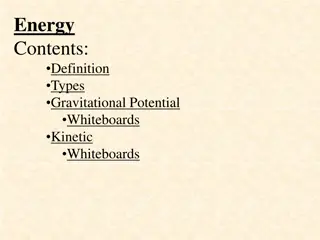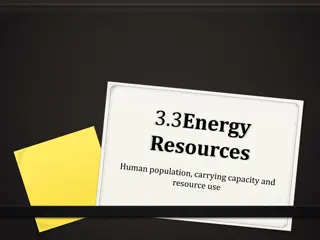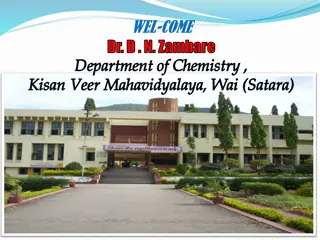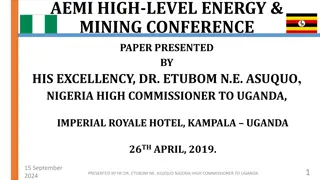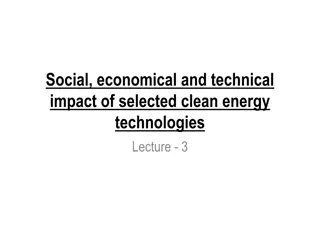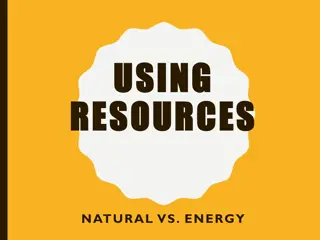Elements and Energy Resources
This content delves into the fundamental aspects of elements, compounds, and physical properties, along with exploring the advantages and disadvantages of various energy resources. Students will learn to differentiate between elements and compounds, identify chemical changes, compare metals, nonmetals, and metalloids, calculate density, and test mineral properties. Additionally, they will research and debate energy sources and design logical plans for energy resource management in different settings.
Download Presentation

Please find below an Image/Link to download the presentation.
The content on the website is provided AS IS for your information and personal use only. It may not be sold, licensed, or shared on other websites without obtaining consent from the author.If you encounter any issues during the download, it is possible that the publisher has removed the file from their server.
You are allowed to download the files provided on this website for personal or commercial use, subject to the condition that they are used lawfully. All files are the property of their respective owners.
The content on the website is provided AS IS for your information and personal use only. It may not be sold, licensed, or shared on other websites without obtaining consent from the author.
E N D
Presentation Transcript
know that an element is a pure substance represented by chemical symbols.[6.5A] October 2014 Secondary Science - 6th Grade
recognize that a limited number of the many known elements comprise the largest portion of solid Earth, living matter, oceans, and the atmosphere.[6.5B] October 2014 Secondary Science - 6th Grade
differentiate between elements and compounds on the most basic level.[6.5C] October 2014 Secondary Science - 6th Grade
identify the formation of a new substance by using the evidence of a possible chemical change such as production of a gas, change in temperature, production of a precipitate, or color change.[6.5D] October 2014 Secondary Science - 6th Grade
compare metals, nonmetals, and metalloids using physical properties such as luster, conductivity, or malleability.[6.6A] October 2014 Secondary Science - 6th Grade
calculate density to identify an unknown substance.[6.6B] October 2014 Secondary Science - 6th Grade
test the physical properties of minerals, including hardness, color, luster, and streak.[6.6C] October 2014 Secondary Science - 6th Grade
research and debate the advantages and disadvantages of using coal, oil, natural gas, nuclear power, biomass, wind, hydropower, geothermal, and solar resources.[6.7A] October 2014 Secondary Science - 6th Grade
design a logical plan to manage energy resources in the home, school, or community.[6.7B] October 2014 Secondary Science - 6th Grade
compare and contrast potential and kinetic energy.[6.8A] October 2014 Secondary Science - 6th Grade
identify and describe the changes in position, direction, and speed of an object when acted upon by unbalanced forces.[6.8B] October 2014 Secondary Science - 6th Grade
calculate average speed using distance and time measurements.[6.8C] October 2014 Secondary Science - 6th Grade
measure and graph changes in motion.[6.8D] October 2014 Secondary Science - 6th Grade
investigate how inclined planes and pulleys can be used to change the amount of force to move an object.[6.8E] October 2014 Secondary Science - 6th Grade
investigate methods of thermal energy transfer, including conduction, convection, and radiation.[6.9A] October 2014 Secondary Science - 6th Grade
verify through investigations that thermal energy moves in a predictable pattern from warmer to cooler until all the substances attain the same temperature such as an ice cube melting.[6.9B] October 2014 Secondary Science - 6th Grade
demonstrate energy transformations such as energy in a flashlight battery changes from chemical energy to electrical energy to light energy.[6.9C] October 2014 Secondary Science - 6th Grade
build a model to illustrate the structural layers of Earth, including the inner core, outer core, mantle, crust, asthenosphere, and lithosphere.[6.10A] October 2014 Secondary Science - 6th Grade
classify rocks as metamorphic, igneous, or sedimentary by the processes of their formation.[6.10B] October 2014 Secondary Science - 6th Grade
identify the major tectonic plates, including Eurasian, African, Indo-Australian, Pacific, North American, and South American.[6.10C] October 2014 Secondary Science - 6th Grade
describe how plate tectonics causes major geological events such as ocean basins, earthquakes, volcanic eruptions, and mountain building.[6.10D] October 2014 Secondary Science - 6th Grade
describe the physical properties, locations, and movements of the Sun, planets, Galilean moons, meteors, asteroids, and comets.[6.11A] October 2014 Secondary Science - 6th Grade
understand that gravity is the force that governs the motion of our solar system.[6.11B] October 2014 Secondary Science - 6th Grade
describe the history and future of space exploration, including the types of equipment and transportation needed for space travel.[6.11C] October 2014 Secondary Science - 6th Grade
understand that all organisms are composed of one or more cells.[6.12A] October 2014 Secondary Science - 6th Grade
recognize that the presence of a nucleus determines whether a cell is prokaryotic or eukaryotic.[6.12B] October 2014 Secondary Science - 6th Grade
recognize that the broadest taxonomic classification of living organisms is divided into currently recognized Domains.[6.12C] October 2014 Secondary Science - 6th Grade
dentify the basic characteristics of organisms, including prokaryotic or eukaryotic, unicellular or multicellular, autotrophic or heterotrophic, and mode of reproduction, that further classify them in the currently recognized Kingdoms.[6.12D] October 2014 Secondary Science - 6th Grade
describe biotic and abiotic parts of an ecosystem in which organisms interact.[6.12E] October 2014 Secondary Science - 6th Grade
diagram the levels of organization within an ecosystem, including organism, population, community, and ecosystem.[6.12F] October 2014 Secondary Science - 6th Grade




